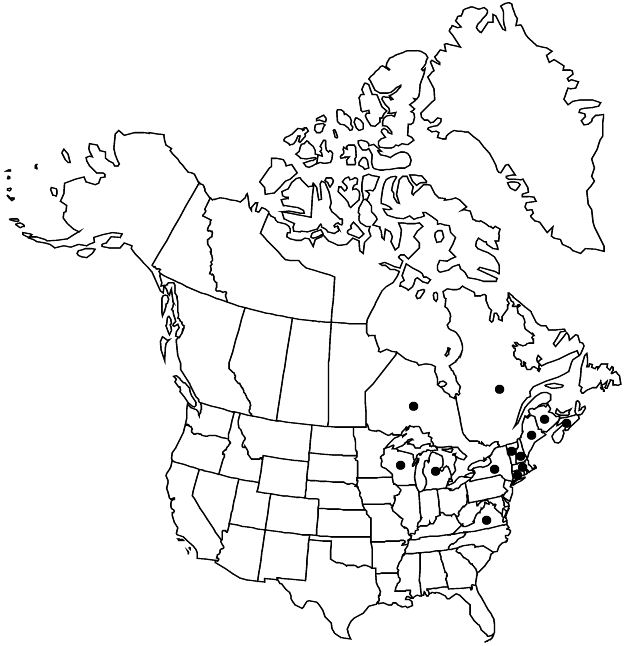Difference between revisions of "Crataegus scabrida"
Rhodora 3: 29. 1901.
FNA>Volume Importer |
FNA>Volume Importer |
||
| Line 16: | Line 16: | ||
|name=Crataegus brainerdii var. scabrida | |name=Crataegus brainerdii var. scabrida | ||
|authority=(Sargent) Eggleston | |authority=(Sargent) Eggleston | ||
| + | |rank=variety | ||
}} | }} | ||
|hierarchy=Rosaceae;Rosaceae subfam. Amygdaloideae;Rosaceae tribe Gillenieae;Crataegus;Crataegus sect. Macracanthae;Crataegus (sect. Macracanthae) ser. Anomalae;Crataegus scabrida | |hierarchy=Rosaceae;Rosaceae subfam. Amygdaloideae;Rosaceae tribe Gillenieae;Crataegus;Crataegus sect. Macracanthae;Crataegus (sect. Macracanthae) ser. Anomalae;Crataegus scabrida | ||
| Line 68: | Line 69: | ||
-->{{#Taxon: | -->{{#Taxon: | ||
name=Crataegus scabrida | name=Crataegus scabrida | ||
| − | |||
|authority=Sargent | |authority=Sargent | ||
|rank=species | |rank=species | ||
| Line 80: | Line 80: | ||
|publication year=1901 | |publication year=1901 | ||
|special status=Endemic | |special status=Endemic | ||
| − | |source xml=https://jpend@bitbucket.org/aafc-mbb/fna-data-curation.git/src/ | + | |source xml=https://jpend@bitbucket.org/aafc-mbb/fna-data-curation.git/src/f50eec43f223ca0e34566be0b046453a0960e173/coarse_grained_fna_xml/V9/V9_885.xml |
|subfamily=Rosaceae subfam. Amygdaloideae | |subfamily=Rosaceae subfam. Amygdaloideae | ||
|tribe=Rosaceae tribe Gillenieae | |tribe=Rosaceae tribe Gillenieae | ||
Revision as of 23:44, 16 December 2019
Shrubs, 30–50 dm. Stems: twigs: new growth reddish early, glabrous, 1-year old deep tan, 2-years old tan to deep reddish brown, older dull gray; thorns on twigs at 1-year old shiny, dark brown to nearly black, stout or slender, 4–6 cm. Leaves: petiole slender, length 40–60% blade, sparsely pubescent or glabrous, eglandular or sessile-glandular; blade short-ovate to ovate, broadly elliptic to narrowly rhombic, or ± trullate, 3–8 cm, base rounded to cuneate, lobes 3–5 per side, margins serrate, veins 5–7(or 8) per side, apex acute, abaxial surface glabrous, adaxial sparsely to densely appressed-pubescent young, glabrescent. Inflorescences 6–10-flowered; branches glabrous or villous. Flowers 15–18 mm diam.; hypanthium glabrous or pubescent; sepals narrowly triangular, margins subentire or glandular-serrate; stamens 7 or 8(–10), anthers pink; styles 3 or 4. Pomes reddish or orange-red, suborbicular, 6–9 mm diam., pruinose, glabrous or slightly pubescent; sepals spreading to ± erose; pyrenes 2–4, sides often pitted. 2n = 51.
Distribution

nc, ne North America.
Discussion
Varieties 4 (4 in the flora).
Crataegus scabrida is variable in leaf shape and size, as well as in pubescence of adaxial leaf surfaces and pedicels. The species falls into four reasonably well-marked varieties, only the first two of which are frequent. The range of the species as a whole is somewhat poorly documented because of frequent incorrect identification.
Selected References
None.
Lower Taxa
Key
| 1 | Inflorescence branches glabrous | > 2 |
| 1 | Inflorescence branches villous | > 3 |
| 2 | Leaf blades ovate to narrowly rhombic, 4–7 cm. | Crataegus scabrida var. scabrida |
| 2 | Leaf blades broadly elliptic, 3–5 cm. | Crataegus scabrida var. cyclophylla |
| 3 | Leaf blades trullate or broadly trullate, 5–8 cm. | Crataegus scabrida var. asperifolia |
| 3 | Leaf blades short-ovate to broadly elliptic, 4 cm. | Crataegus scabrida var. egglestonii |